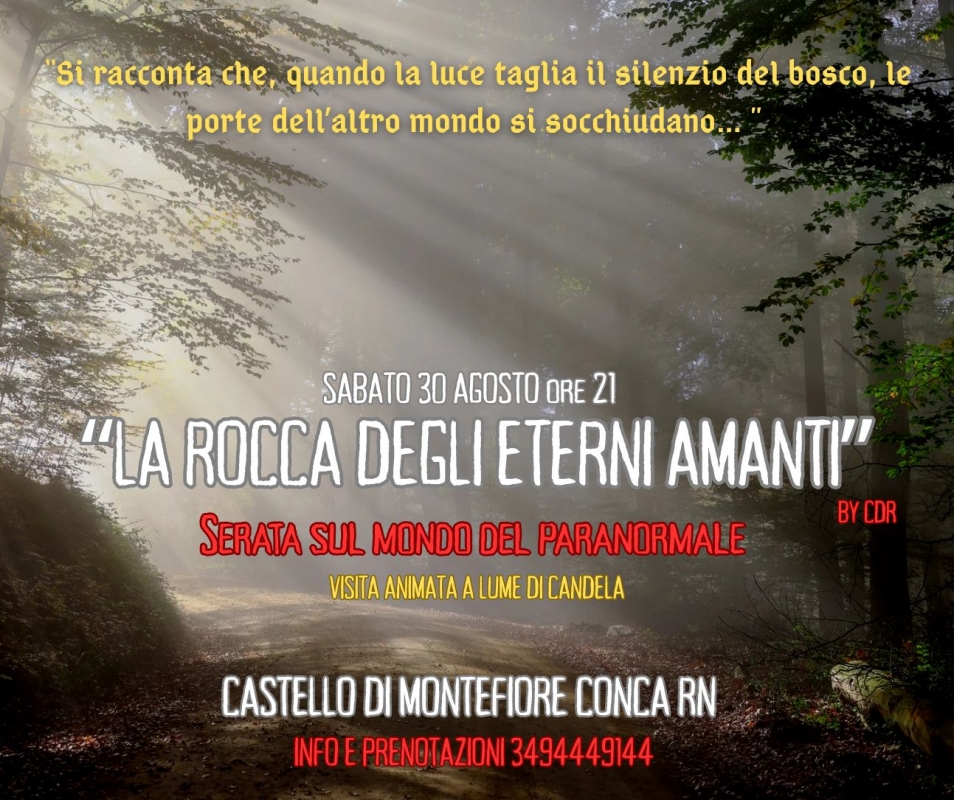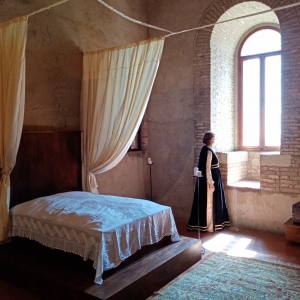Malatesta Rocca

The fortress allows access to small animals, we also recommend a visit to the village with a stop at the Big Bench.
Even from Rimini, in the heart of Romagna, you can catch a glimpse of an imposing fortress on one of the highest hills, surmounted by square walls: It is the Fortress of Montefiore Conca where, according to legend, the souls of two lovers, Costanza Malatesta and Ormanno, the German duke at the service of the Malatesta family with his army of fifty squires on horseback, still roam.
The Castle was built in the 14th century by the Malatesta family and was, as well as a mighty military construction, an elegant residential palace which had the honor of hosting important personalities including the King of Hungary Luigi D'Angiò, Pope Gregory XII and Pope Julius II.
Its position, strategic and at the same time panoramic, allows an overall view of the coasts of Romagna and of the whole valley, up to San Marino and beyond. From there you can admire Romagna, a land with a gentle landscape where the nature of the sea coexists with that of the inland hills, where the gaze finds expanses of fields cultivated in olive trees and vineyards, where suddenly the eyes are enchanted by hamlets positioned on harmonic promontories.
An exciting scenario in which one can get lost in one’s dreams as did the poet Ezra Pound writing the following verses about this place:
“I have tried to write Paradise.
Do not move.
Let the wind speak.
That is Paradise."
In addition to the castle rooms, such as the Emperor's Room with frescoes by Jacopo Avanzi, the Throne Room, some rooms with historical reconstructions and panoramic terraces, the tour itinerary also includes a rich display of archaeological finds uncovered in the waste pits during archaeological excavations, which allow us to reconstruct parts of daily life in the Rocca during the occupation of the Malatesta and Montefeltro families.
The presence of towers, fortresses, walls and castles that still characterizes Romagna and part of the Marche region dates back to the late Middle Ages. In this era the neighboring and often rival families of the Malatestas and Montefeltros fortified all the strategic points giving rise to a real network of defensive structures communicating with each other: once threatening and impregnable, today picturesque corners of peace and tranquillity.
As for 4-legged visitors, we can recommend to tourists traveling with their pets a visit to the Malatesta fortress and its beautiful village, a stop at the Big Bench, and for those who like to walk more, we remember the 60 km of CAI trails, newly cleaned, mapped and marked.
Trail maps are available at the rock ticket office and are free!
Remember that Big Bench passports and stamps are also available at the ticket office.
A bit of history
Located on a hill at 385 meters above sea level, it is in a strategic position that makes it possible to dominate a truly unique panorama that in the past was a military fortune and is today an exciting scenario.
The origins of this hamlet are shrouded in mystery. Its history begins with the findings of the Roman era: They tell us about an ancient settlement connected to its important position on the Flaminia minor. Halfway between Rimini and Urbino it was a point of passage and refreshment for travelers heading to Rome.
Documents tell us that Montefiore was already listed as a Castrum in the 12th century.
The impressive fortress, with its severe and geometric lines, was built during the fourteenth century by the Malatesta family. One of the heydays of the hamlet dates back to this era, with a population of around 720 people.
The Rocca was born as a mighty war machine, part of a system of defensive structures devoted to the control of the Malatesta territories.
During the second half of the 1300s, and in particular during the reign of Malatesta Ungaro, the military function was combined with the residential one. The fortress of Montefiore Conca, expanded and enriched with frescoes and decorations, became with its large halls, one of the favorite summer residences of the family and a place to receive and entertain guests of the caliber of the King of Hungary Luigi D'Angiò, Pope Gregory XII first and then Julius II, and many others.
With the conquest of Montefiore Conca by the troops of Federico da Montefeltro, from the 16th century the area returned under the direct control of the Holy See, so much so that the villagers carved the weapon of Pius II on the entrance gate to the hamlet.
From 1463 to 1530 various owners succeeded the reign of Montefiore, among whom we recall the occupation of Cesare Borgia (1503), of the Republic of Venice (1504 - 1505) and from 1514, of the prince of Macedonia Costantino Comneno, who died here in 1530.
From the mid-fifteenth century the Rocca, owned by the Papal State until the unification of Italy, underwent a process of progressive dereliction. Neglect, looting, earthquakes, wars and other devastations reduced the entire structure to a state of degradation that subsided only after the Second World War. The first major restoration projects took place between the 1950s and the 1970s and set up partially disproportionate reconstruction work, but were fundamental for an initial preservation of the building.
The current appearance is instead the result of the painstaking work during the period 2006 - 2008, during which original parts of the ancient Malatesta structure were brought to light. Stability was given to the whole structure and some dubious elements deriving from the previous reconstruction were repaired.
Ghost and legends
The Rocca of the eternal lovers. It is said that the souls of two lovers still wander within the walls of the castle: Costanza Malatesta and Ormanno. But who were they?
Costanza Malatesta was the daughter of Malatesta Ungaro and Violante D'Este; we do not know the exact date of her birth or even the date of her death: Although apparently established as having occurred on October 15th, 1378, it is shrouded in an aura of mystery.
The beautiful girl, who grew up between the courts of Rimini and that of Pesaro, was Ungaro’s only legitimate daughter. Well educated, she always stood out for her bizarre character and was not inclined to obedience; for this reason her father decided to guarantee her a dowry of 50,000 ducats in order to make her "more attractive" on the market of marriage strategies of the time. In 1363, in order to consolidate the alliance with the D'Este family, it was decided that there was to be a marriage between blood relatives and she married her young uncle Ugo D'Este. He died at the age of 26 during a fight, after only 7 years of marriage, leaving Costanza Malatesta, perhaps not yet twenty, a widow and with a rich inheritance. The girl then returned to Romagna to the court of her uncle Galeotto the Bold and her father Malatesta IV. Her love story with Ormanno, a German duke in the service of Malatesta with his army of fifty squires on horseback started then; it is said that the two met for the first time and fell madly in love with each other.
“Messer Galeotto had one of his soldiers, who was a corporal of fifty squires; his name was Ormanno, and he was German [...] Now it happened that the said Ormanno, passing several times by the palace of Madonna Costanza, the woman being at the windows, their gazes fell on each other in such a way that Ormanno fell deeply in love with this woman, and knew how to keep such ways, that the woman became aware of it, and began to fall in love with him. […]
(Taken from: “Il pecorone” (The large sheep) by Giovanni Fiorentino
Their love story was lived in secret but, after the death of her father, her uncle Galeotto decided to lay his hand on the girl's conspicuous inheritance and to do this he obviously had to look for a pretext. And he found it ...
He discovered this love story and accused his niece of being shameless, as her behavior tarnished the reputation of the Malatesta family, and all of this was unacceptable to him. So, he decided to punish her ruthlessly. On the night of October 15th, 1378, the two lovers were discovered lying together and were barbarously killed by an assassin hired by her uncle...
Nothing more was ever heard of the two unfortunate lovers but, legend has it, that on October nights, the girl’s weeping can still be heard in the rooms of the castle.
Numerous studies have been carried out involving ghost hunters and researchers on the so-called paranormal phenomena (by the specialized group called "Research Company") which seem to take place inside the fortress.
The love story of Costanza and Ormanno was told in a small book: "Il Biancospino" (The Hawthorn).
Another interesting legend involving the castle is the one that tells of Sigismondo's treasure. There has always been talk of this treasure so well hidden as to make the countless attempts to find it useless.
The origin of this belief derives from an event of April 7th, 1464. In that year Sigismondo Pandolfo Malatesta was engaged as captain of the Venetian troops in Morea and some criminals took advantage of his absence and attempted a conspiracy. However, this was discovered and during the investigations a witness revealed that, in addition to taking over the government of the town, the traitors wanted to take possession of Sigismondo's "treasure" which was hidden somewhere within the walls of Montefiore Conca.
But which of the castle’s walls are those mysterious walls? In the external walls erected to defend the Fortress of Montefiore, in the area called "Fratta", there is a tower that the inhabitants of Montefiore have always called "The Tower of the Treasure". This is a peculiar tower, completely filled with a pouring of stones and white lime to make it impossible for anyone to access it. It was struck several times by lightning. These facts immediately made people think that inside the tower there was some kind of metallic material, the material that was believed to represent the Treasure of the Malatesta family, and for this reason it was called the "Tower of the Treasure". To ward off those with bad intentions, it was later dubbed "The Devil's Tower".












